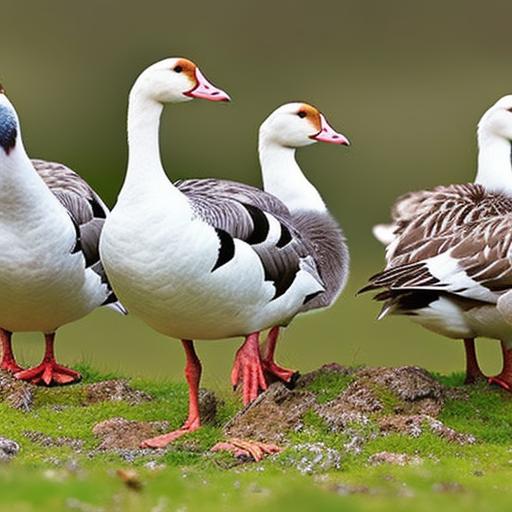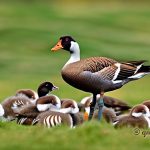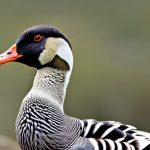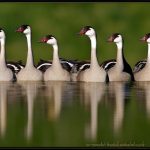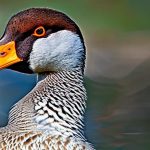Domestic geese are a popular and versatile breed of poultry that have been domesticated for thousands of years. They are known for their distinctive appearance, with long necks, webbed feet, and a honking call. Domestic geese are found all over the world and come in a variety of breeds, each with its own unique characteristics.
Domestic geese have been an important part of agriculture for centuries. They are raised for their meat, eggs, and feathers, and are also kept as pets and for ornamental purposes. They are hardy birds that can adapt to a wide range of climates and are relatively easy to care for. Whether you’re looking to raise geese for food or simply as companions, there is a breed out there that will suit your needs.
Key Takeaways
- Domestic geese breeds have been raised for thousands of years for their meat, eggs, and feathers.
- Physical characteristics of domestic geese breeds include a long neck, webbed feet, and a broad, flat beak.
- Popular domestic geese breeds in North America include the Toulouse, Embden, and African.
- Rare domestic geese breeds include the Pilgrim, Sebastopol, and Steinbacher.
- The best domestic geese breeds for meat production are the Embden and Toulouse, while the Chinese and African are good for egg production.
The History of Domestic Geese Breeds
The domestication of geese can be traced back to ancient times. It is believed that the wild ancestor of domestic geese is the greylag goose, which is native to Europe and Asia. These wild geese were first domesticated in ancient Egypt around 4,000 years ago. From there, they spread to other parts of the world, including Europe and North America.
Over time, different breeds of domestic geese were developed through selective breeding. This allowed farmers to create birds with specific traits that were desirable for different purposes. For example, some breeds were bred for their large size and meat production, while others were bred for their egg-laying abilities.
Historically, domestic geese have been used for a variety of purposes. In addition to their meat and eggs, geese were also valued for their feathers, which were used to make pillows, mattresses, and quill pens. They were also used as guard animals, as they are known to be territorial and will often chase away intruders.
Physical Characteristics of Domestic Geese Breeds
Domestic geese come in a wide range of sizes, weights, and colors. The average weight of a domestic goose can range from 10 to 20 pounds, depending on the breed. Some breeds, such as the Toulouse and Embden, are larger and heavier, while others, such as the African and Chinese, are smaller and lighter.
Feather colors and patterns also vary among domestic geese breeds. The most common color is white, but there are also breeds that come in shades of gray, brown, and black. Some breeds have solid-colored feathers, while others have patterns or markings.
The color of a goose’s beak and legs can also vary. Most domestic geese have orange or pink beaks and legs, but there are some breeds that have black or gray beaks and legs.
There are also differences between male and female geese. Males, known as ganders, are generally larger than females, known as geese. They also tend to have louder calls and more aggressive behavior, especially during breeding season.
Popular Domestic Geese Breeds in North America
In North America, there are several popular breeds of domestic geese that are commonly raised for meat, eggs, or as pets. One of the most popular breeds is the Toulouse goose. Toulouse geese are large birds with gray feathers and orange beaks and legs. They are known for their calm and friendly temperament.
Another popular breed is the Embden goose. Embden geese are also large birds, but they have white feathers and orange beaks and legs. They are known for their excellent meat production and are often raised for commercial purposes.
The African goose is another popular breed in North America. African geese are smaller than Toulouse and Embden geese, but they are still relatively large birds. They have gray feathers and orange beaks and legs. African geese are known for their excellent egg-laying abilities and are often kept for their eggs.
Rare Domestic Geese Breeds and Their Characteristics
In addition to the popular breeds, there are also several rare breeds of domestic geese that are less commonly seen. These breeds often have unique physical characteristics and are prized for their rarity.
One example of a rare breed is the Pilgrim goose. Pilgrim geese are medium-sized birds with gray feathers and orange beaks and legs. They are known for their calm and docile temperament, making them a popular choice for backyard flocks.
Another rare breed is the Sebastopol goose. Sebastopol geese are known for their unique feathering, which is curly and fluffy. They come in a variety of colors, including white, gray, and buff. Sebastopol geese are often kept for ornamental purposes and are prized for their beautiful appearance.
The Steinbacher goose is another rare breed that is known for its unique appearance. Steinbacher geese have white feathers with black markings on their heads and necks. They also have a distinctive knob on their beaks. Steinbacher geese are often kept as pets or for exhibition purposes.
The Best Domestic Geese Breeds for Meat Production
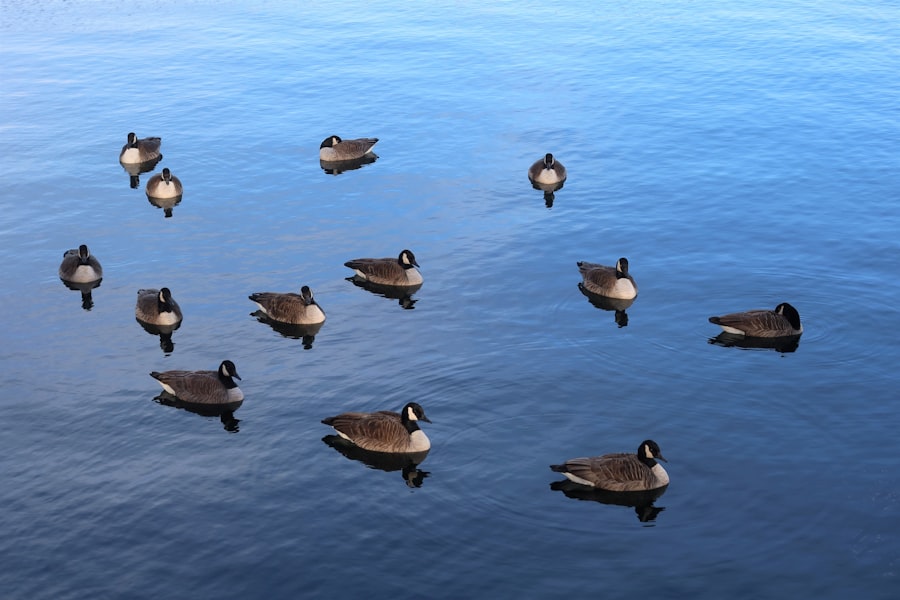
If you’re looking to raise geese for meat production, there are several breeds that are known for their excellent meat quality and growth rate. One of the best breeds for meat production is the Pekin goose. Pekin geese are large birds with white feathers and orange beaks and legs. They have a high meat-to-bone ratio and grow quickly, making them an ideal choice for meat production.
Another breed that is commonly raised for meat is the Chinese goose. Chinese geese are smaller than Pekin geese, but they still have good meat quality. They have gray feathers and orange beaks and legs. Chinese geese are also known for their excellent foraging abilities, which makes them a cost-effective choice for meat production.
Domestic Geese Breeds for Egg Production
If you’re looking to raise geese for egg production, there are several breeds that are known for their excellent egg-laying abilities. One of the best breeds for egg production is the Roman goose. Roman geese are medium-sized birds with white feathers and orange beaks and legs. They are known for their high egg production and can lay up to 50 eggs per year.
Another breed that is commonly raised for eggs is the Buff goose. Buff geese are medium-sized birds with buff-colored feathers and orange beaks and legs. They are known for their good egg-laying abilities and can lay up to 40 eggs per year.
Domestic Geese Breeds for Ornamental Purposes
If you’re looking to keep geese for ornamental purposes, there are several breeds that are known for their unique appearance and beautiful feathers. One of the best breeds for ornamental purposes is the Sebastopol goose. Sebastopol geese have curly and fluffy feathers that come in a variety of colors, including white, gray, and buff. They are often kept as pets or for exhibition purposes.
Another breed that is prized for its ornamental value is the Cotton Patch goose. Cotton Patch geese have white feathers with black markings on their heads and necks. They also have a distinctive knob on their beaks. Cotton Patch geese are often kept for their beautiful appearance and are popular among collectors.
Caring for Domestic Geese Breeds: Feeding, Housing, and Health
Caring for domestic geese requires providing them with proper nutrition, housing, and healthcare. Geese are grazers by nature and should have access to fresh grass or pasture as much as possible. They also require a balanced diet that includes grains, vegetables, and protein sources such as insects or fish.
When it comes to housing, geese need a secure and spacious enclosure that protects them from predators and provides shelter from the elements. They also need access to water for swimming and grooming. Geese are social animals and should be kept in pairs or small groups to prevent loneliness and stress.
Geese are generally hardy birds, but they can still be susceptible to certain health issues. Common health problems in geese include respiratory infections, parasites, and foot problems. Regular veterinary check-ups and proper hygiene practices can help prevent these issues. It’s also important to provide geese with a clean and dry living environment to minimize the risk of disease.
Breeding Domestic Geese: Tips and Techniques for Successful Reproduction
Breeding domestic geese requires careful selection of breeding pairs and proper incubation and hatching techniques. When selecting breeding pairs, it’s important to choose birds that are healthy, have good conformation, and exhibit desirable traits such as good meat or egg production. It’s also important to avoid breeding closely related birds to prevent genetic issues.
Incubating and hatching goslings can be done using an incubator or by allowing the female goose to sit on the eggs. If using an incubator, it’s important to maintain the correct temperature and humidity levels throughout the incubation period. If allowing the female goose to sit on the eggs, it’s important to provide her with a quiet and secure nesting area.
Once the goslings hatch, they should be provided with a warm and safe environment. They should have access to clean water, starter feed, and a brooder that is kept at the correct temperature. It’s also important to handle goslings gently and provide them with plenty of socialization to ensure they grow up to be friendly and well-adjusted birds.
Domestic geese breeds come in a variety of sizes, colors, and temperaments, making them a versatile and popular choice for farmers, homesteaders, and pet owners. Whether you’re looking to raise geese for meat, eggs, or simply as companions, there is a breed out there that will suit your needs. By providing proper care and using effective breeding techniques, you can ensure the health and success of your domestic geese flock.
If you’re interested in learning more about domestic geese breeds, you might also find this article on Poultry Wizard fascinating. It explores the question of whether geese can eat chicken feed. To find out if it’s safe to feed your geese with chicken feed, click here: Can Geese Eat Chicken Feed?
FAQs
What are domestic geese breeds?
Domestic geese breeds are breeds of geese that have been selectively bred by humans for various purposes such as meat, eggs, feathers, and as pets.
How many domestic geese breeds are there?
There are over 20 domestic geese breeds recognized by the American Poultry Association, and many more breeds that are not officially recognized.
What are some common domestic geese breeds?
Some common domestic geese breeds include Toulouse, Embden, African, Chinese, and Sebastopol.
What is the difference between male and female domestic geese?
Male domestic geese, also known as ganders, are generally larger and have a more prominent knob on their beak than females, also known as geese.
What are domestic geese used for?
Domestic geese are used for various purposes such as meat, eggs, feathers, and as pets. They are also used for weed control and as guard animals.
What is the lifespan of domestic geese?
The lifespan of domestic geese varies depending on the breed and their living conditions, but they can live up to 20 years.
What is the average weight of domestic geese?
The average weight of domestic geese varies depending on the breed, but they can weigh anywhere from 8 to 20 pounds.
What is the temperament of domestic geese?
The temperament of domestic geese varies depending on the breed and their upbringing, but they are generally social animals that can become protective of their flock and territory.
Meet Walter, the feathered-friend fanatic of Florida! Nestled in the sunshine state, Walter struts through life with his feathered companions, clucking his way to happiness. With a coop that’s fancier than a five-star hotel, he’s the Don Juan of the chicken world. When he’s not teaching his hens to do the cha-cha, you’ll find him in a heated debate with his prized rooster, Sir Clucks-a-Lot. Walter’s poultry passion is no yolk; he’s the sunny-side-up guy you never knew you needed in your flock of friends!

